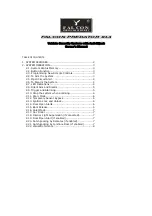
VESDA-E VEP-A00-P Product Guide
www.xtralis.com
95
B
Glossary
Term
Description
A
Aspirator
Impeller type fan used to draw sampled air into the detector.
AutoLearn Smoke
A feature which allows the detector to learn its environment
(background pollution, differences between day and night
operations within the facility etc) in order to set appropriate
alarm thresholds for that environment.
AutoLearn Flow
A feature which allows the detector to learn its airflow
behavior in the installed environment. This information is
used by the detector to set appropriate airflow trouble
thresholds.
C
Capillary Tubes
Flexible tubes attached to the sampling pipe network for
sampling specific areas away from the sampling pipe.
Commissioning
The process of making a smoke detection system
operational.
Condition
For example, Fire 1 condition, Urgent Fault condition. The
detector is said to be in the Fire 1 condition when it has
detected a Fire 1 alarm.
D
Disable
When the detector is disabled the detector will not signal
alarms and faults via its relays. The detector signals that it is
disabled using Relay 1. (Disable was previously referred to
as isolate.)
E
Event Log
A data log of events (for example, alarms, troubles, user
commands) which is stored in the detector.
F
Fault
An urgent fault is a condition where the system requires
urgent attention as it may be unable to detect an alarm
condition.
A minor fault is a condition where the system requires
attention or maintenance, but is still able to detect an alarm
condition.
Fire Alarm Control Panel (FACP)
A central monitoring and control system to which all smoke
detectors report their status.
G
General Purpose Input (GPI)
Unmonitored
An input to the detector which can be used to initiate a user
configurable action. Applying a voltage between 5V and
30VDC triggers the selected action.
General Purpose Input (GPI) Monitored
The monitored GPI senses contact closure and is
configurable to initiate the same actions as the unmonitored
GPI. In particular, it can be used to monitor the power
supply.
H
High Airflow Environment
Where there are 10 or more air exchanges per hour.
High Level Interface (HLI)
A communications interface between a VESDA device and
other pieces of equipment using another communications
protocol.
L
Latching
If the cause of a condition is removed (for example, smoke
decreases below the threshold) and latching is enabled, the
detector “remembers” the condition and holds the
corresponding relays and displays in the active state as
though the cause of the condition were still active.
Table B-1: Glossary
Summary of Contents for VESDA-E VEP-A00
Page 2: ......
Page 8: ...VESDA E VEP A00 P Product Guide vi www xtralis com This page is intentionally left blank ...
Page 12: ...VESDA E VEP A00 P Product Guide 4 www xtralis com This page is intentionally left blank ...
Page 22: ...VESDA E VEP A00 P Product Guide 14 www xtralis com This page is intentionally left blank ...
Page 102: ...VESDA E VEP A00 P Product Guide 94 www xtralis com This page is intentionally left blank ...
Page 108: ...VESDA E VEP A00 P Product Guide 100 www xtralis com This page is intentionally left blank ...







































